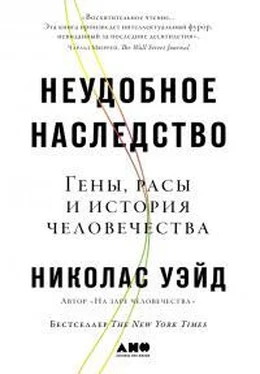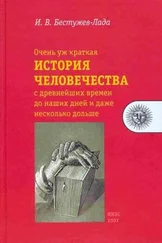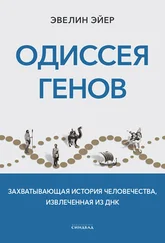В книге «Инстинкт веры» исследовалась эволюционная роль религии как связующего и мотивирующего фактора в человеческих сообществах. Эта работа рассматривает новые данные исследований человеческого генома, которые пролили свет на возникновение разных рас внутри человечества.
Я благодарю Питера Мэтсона из Sterling Lord Literistic за первоначальную постановку задач этой книги. Я чрезвычайно признателен Скотту Мойерсу из Penguin Press за скрупулезную критику книги и за безошибочное редакторское чутье и мастерство, которые помогли нам обойти все опасные рифы и мели.
Я в огромном долгу перед моими друзьями, читавшими первые наброски, — они уберегли меня от многих фактических ошибок и неверных суждений. В первую очередь это Николас Фишер из Абердинского университета, Джереми Стоун из организации «Каталитическая дипломатия», Ричард Тэппер из «Школы восточных и африканских исследований» Лондонского университета, а также мой сын Александр Уэйд из организации «Врачи без границ».
Глава 1. Эволюция, раса и история
1. Joshua M. Akey, “Constructing Genomic Maps of Positive Selection in Humans: Where Do We Go from Here?” Genome Research 19 (2009): 711–22.
2. Sandra Wilde et al, “Direct Evidence for Positive Selection of Skin, Hair, and Eye Pigmentation in Europeans During the Last 5,000 y,” Proceedings of the National Academy of Sciences 111 (2013): 4832–837.
3. Emmanuel Milot et al., “Evidence for Evolution in Response to Natural Selection in a Contemporary Human Population,” Proceedings of the National Academy of Sciences, 108 (2011): 17040–45.
4. Stephen C. Stearns et al., “Measuring selection in contemporary human populations,” Nature Reviews Genetics 11, no. 9 (Sept. 2010): 1–13.
5. American Anthropological Association, “Race: A Public Education Project,” www.aaanet.org/resources/A–Public–Education-Program.cfm.
6. Alan H. Goodman, Yolanda T. Moses, and Joseph L. Jones, Race: Are We So Different? (Arlington, VA: American Anthropological Association 2012), 2.
7. American Sociological Association, “The Importance of Collecting Data and Doing Social Scientific Research on Race,” (Washington, DC: American Sociological Association, 2003), www.asanet.org/media/asa_race_statement.pdf.
8. Christopher F. Chabris et al., “Most Reported Genetic Associations with General Intelligence Are Probably False Positives,” Psychological Science 20, no. 10 (Sept. 24, 2012): 1–10.
9. David Epstein, The Sports Gene: Inside the Science of Extraordinary Athletic Performance (New York: Current 2013), 176.
Глава 2. Научные отклонения
1. Richard Hofstadter, Social Darwinism in American Thought, (Boston: Beacon Press, 1992), 171.
2. Benjamin Isaac, The Invention of Racism in Classical Antiquity, (Princeton, NJ: Princeton University Press, 2004), 23.
3. Nell Irving Painter, “Why White People Are Called ‘Caucasian’?” paper presented at the Fifth Annual Gilder Lehrman Center International Conference, Yale University, New Haven, CT, Nov. 7–8, 2003, www.yale.edu/glc/events/race/Painter.pdf.
4. Jason E. Lewis et al., “The Mismeasure of Science: Stephen Jay Gould Versus Samuel George Morton on Skulls and Bias,” PLoS Biology 9, no. 6 (June 7, 2011), www.plosbiology.org/article/info%3Adoi%2F10.1371%2Fjournal.pbio.1001071.
5. Hofstadter, Social Darwinism, xvi.
6. Charles Darwin, The Descent of Man and Selection in Relation to Sex, 2d ed. (New York: Appleton, 1898), 136.
7. Nicholas Wright Gillham, A Life of Sir Francis Galton: From African Exploration to the Birth of Eugenics(New York: Oxford University Press, 2001), 166.
8. Там же, с. 357.
9. Edwin Black, War Against the Weak: Eugenics and America’s Campaign to Create a Master Race (New York: Four Walls Eight Windows, 2003), 37.
10. Там же, с. 45–47.
11. Там же, с. 90.
12. Daniel J. Kevles, In the Name of Eugenics: Genetics and the Uses of Human Heredity (New York: Knopf, 1985), 69.
13. Black, War Against the Weak, 87.
14. Там же, с. 99.
15. Kevles, In the Name of Eugenics, 81.
16. Там же, с. 106.
17. Black, War Against the Weak, 123.
18. Kevles, In the Name of Eugenics, 97.
19. Black, War Against the Weak, 393.
20. Madison Grant, The Passing of the Great Race; or, The Racial Basis of European History, 4th ed. (New York: Charles Scribner, 1932), 170.
21. Там же, с. 263.
22. Jonathan P. Spiro, Defending the Master Race: Conservation, Eugenics and the Legacy of Madison Grant(Burlington: University of Vermont Press, 2009), 375.
23. Black, War Against the Weak, 100.
24. Там же, с. 259.
25. Kevles, In the Name of Eugenics, 117.
26. Там же, с. 118.
27. Raul Hilberg, The Destruction of the European Jews, (New York: Holmes & Meier, 1985, student edition), 31.
28. Yvonne Sherratt, Hitler’s Philosophers (New Haven, CT: Yale University Press, 2013), 60.
Глава 3. Истоки социальности человека
1. Bernard Chapais, Primeval Kinship: How Pair–Bonding Gave Birth to Human Society, (Cambridge, MA: Harvard University Press, 2008), 4.
2. Charles Darwin, The Descent of Man and Selection in Relation to Sex, 2d ed. (New York: Appleton, 1898), 131.
3. Michael Tomasello, Why We Cooperate (Cambridge, MA: MIT Press, 2009), 27.
4. Там же, с. 23.
5. Там же, с. 7.
6. Esther Herrmann et al., “Humans Have Evolved Specialized Skills of Social Cognition: The Cultural Intelligence Hypothesis,” Science 317, no. 5843 (Sept. 7, 2007): 1360–66.
7. Michael Tomasello and Malinda Carpenter, “Shared Intentionality,” Developmental Science 10, no. 1 (2007): 121–25.
8. Cade McCall and Tania Singer, “The Animal and Human Neuroendocrinology of Social Cognition, Motivation and Behavior,” Nature Neuroscience 15 (2012): 681–88.
9. Carsten K. W. De Dreu et al., “Oxytocin Promotes Human Ethnocentrism,” Proceedings of the National Academy of Sciences 108, no. 4 (Jan. 25, 2011), 1262–66.
10. David H. Skuse et al., “Common Polymorphism in the Oxitocin Receptor Gene (OXTR) Is Associated With Human Recognition Skills,” Proceedings of the U. S. National Academy of Sciences (December 23, 2013).
11. Reviewed in Zoe R. Donaldson and Larry J. Young, “Oxytocin, Vasopressin and the Neurogenesis of Sociality,” Science 322, no. 5903 (Nov. 7, 2008): 900–904.
12. Nicholas Wade, “Nice Rats, Nasty Rats: Maybe It’s All in the Genes,” New York Times, July 25, 2006, www.nytimes.com/2006/07/25/health/25rats.html? pagewanted=all&_r=0 (accessed Sept. 25, 2013).
13. Robert R. H. Anholt and Trudy F. C. Mackay, “Genetics of Aggression,” Annual Reviews of Genetics 46 (2012): 145–64.
14. Guang Guo et al., “The VNTR 2 Repeat in MAOA and Delinquent Behavior in Adolescence and Young Adulthood: Associations and MAOA Promoter Activity,” European Journal of Human Genetics 16 (2008): 624–34.
Читать дальше
Конец ознакомительного отрывка
Купить книгу




![Юваль Ной Харари - Sapiens. Краткая история человечества [litres]](/books/34310/yuval-noj-harari-sapiens-kratkaya-istoriya-cheloveche-thumb.webp)







